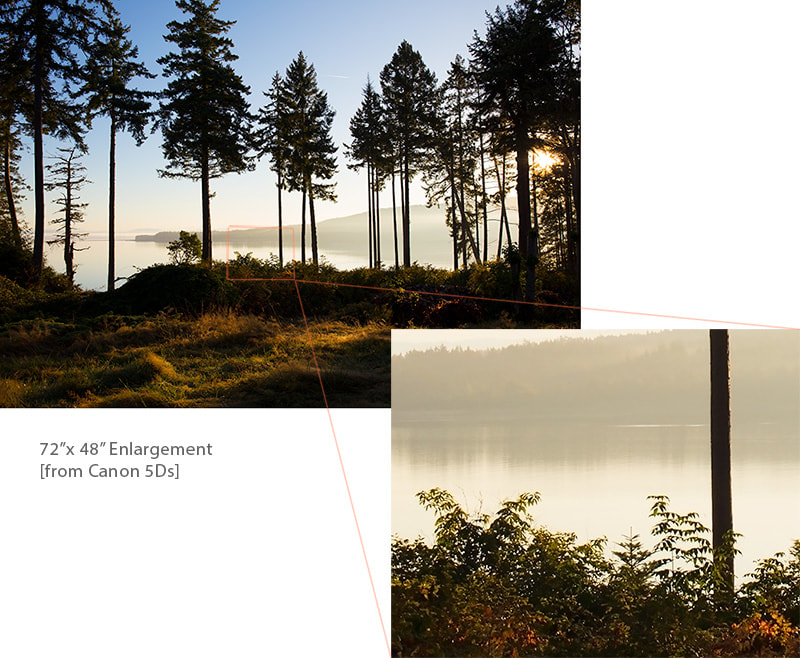Image editing/Optimization
FINE ART STANDARD FOR ENLARGEMENT
When a print is viewed close up you should clearly see the image, be it sharp detail or soft tonal gradation, not the pixels. The time to stop enlarging is when you start to lose that degree of image quality, because a print should be satisfying whatever distance it's viewed from. This was the ethos of the famous "Group f/64" and has remained the serious photographic printers' benchmark ever since.
Founded by Ansel Adams, Edward Weston, Willard Van Dyke and others (first exhibition, 1931, prints $10/$15!), "Group f/64" got it's name from their favoured technique of using the smallest f.stop available to achieve maximum 'depth of field' (sharp focus from foreground to infinity). They saw no point in capturing all that sharp detail then compromising it with the 'structure' of the substrate on which the image is recorded, i.e. visible film grain. I apply the same standard to digital printing, just replace the term "film grain" with "pixels". Bigger is not necessarily better...
Founded by Ansel Adams, Edward Weston, Willard Van Dyke and others (first exhibition, 1931, prints $10/$15!), "Group f/64" got it's name from their favoured technique of using the smallest f.stop available to achieve maximum 'depth of field' (sharp focus from foreground to infinity). They saw no point in capturing all that sharp detail then compromising it with the 'structure' of the substrate on which the image is recorded, i.e. visible film grain. I apply the same standard to digital printing, just replace the term "film grain" with "pixels". Bigger is not necessarily better...
Achieving jaw-dropping enlargements obviously depends on the quality of the image file. It isn't just a matter of mega-bytes although the more the merrier, the camera make, model, age (of the technology), the lens and even the subject itself, all play an important role in determining how large an image will go and still work. However, with the latest software available (plus decades of experience) stunning prints can frequently be achieved at much larger sizes than you might expect. So if it's got to go to eight foot wide and look good close up, upload the file for a free appraisal and I'll tell you if it can be done.
complimentary image optimizationTo bring out the best in every photograph, they all receive our complementary "image optimization" before printing and for most that's all that's needed. This consists of 'global' adjustments (adjustments to the whole image) including correction of colour casts, improvement of tonal range, adjustment of colour saturation, etc. and basic image cleanup.
luminance noise + colour noiseLuminance noise is the digital equivalent of "grain" in traditional film and is most noticeable and undesirable in areas of smooth tonal gradation, such as clouds, water and snow.
|
|
Just as ugly is the colour noise that so often accompanies it, pixels of pure colour - most often magenta and cyan - that simply don't belong in your photograph! Unless you know what you are looking for you may not be aware that your image has these issues because when you view it on a screen it's too often small to draw attention.
When printing an image this will be a serious limitation to enlargement if left untreated, obviously the larger it gets the more noticeable it becomes. How serious and how effectively it can be dealt with depends on many variables, starting with the size and quality of your camera's image sensor. Low light and increasing the ISO usually make it worse, although the new generation of high-end Nikon cameras seem to have solved the problem of colour noise even when shooting at night! However, for those of you not fortunate to own one of these we are here to make sure that your photographs look good even up close.
It is preferable to apply colour noise reduction as part of the initial image clean up but it can be done at any stage. However it is important to realise that pixel noise reduction must be done after enlargement so we ask that you do not attempt either that or sharpening on your images before uploading them to us unless you really know what you are doing and are sending us print ready files. We do not charge for this service, it is part of our Complementary Image Optimisation.
It is preferable to apply colour noise reduction as part of the initial image clean up but it can be done at any stage. However it is important to realise that pixel noise reduction must be done after enlargement so we ask that you do not attempt either that or sharpening on your images before uploading them to us unless you really know what you are doing and are sending us print ready files. We do not charge for this service, it is part of our Complementary Image Optimisation.
chargeable image optimizations
We will advise if there are issues requiring more work, such as the rescue the of highlight or shadow details from over or underexposed areas requiring specific area selections, excessive image clean up including the removal of unwanted objects and most common, the removal of 'fringing' as explained above. We will always either give you a quote or an estimate before commencing the work.
Colour Fringing / Digital Fringing
Whilst you may encounter chromatic aberration with some digital camera lenses (most commonly long telephotos), a more likely cause of coloured fringing in digital photos is blooming which occurs when a group of photodiodes on an image sensor receive more light than they can handle. The resulting electrical charge overflows into adjacent photodiodes, which lose their ability to record a signal that is proportional to the incoming light they receive. This will produce an area in which the image data is corrupted.
Blooming is most obvious in regions in digital photographs that are over-exposed. It can appear in any part of a photograph - including the centre - and, because different colour channels react differently to over-exposure, the edges of areas of blooming can vary with different wavelengths, hence the coloured fringes. These can mostly be eliminated with the noise reduction filter in PhotoShop but often leave behind a white fringe which is almost as bad. Edges between two areas of differing brightness can also result in side-by-side black and white fringing.
This problem becomes exaggerated when we try to manipulate and 'push' the colour and tonal values of an image and the more we try to enlarge that image the more it's going to show. However, this need not be seen as an impediment to enlargement because it can be cleaned up, as shown below.
This problem becomes exaggerated when we try to manipulate and 'push' the colour and tonal values of an image and the more we try to enlarge that image the more it's going to show. However, this need not be seen as an impediment to enlargement because it can be cleaned up, as shown below.
image editingThis Example: Cost of Improvements
1] General improvements to colour, tone, saturation etc. Free 2] Removal of text from the BRHC and the hands from behind the boy's head $25 (Courtesy of M McNamara, Hornby Island, BC) |
|
peace of mind
When you send your image files to PrintArtPhotography.ca you can rest assured that you will receive the best possible prints. Unlike the 'average' print lab we don't just print what you send us and expect you to accept the result whether it's good or bad. Because we care about our reputation we have to care about yours - we take responsibility for the outcome and only the best will do! This approach leads to loyal clients and more reorders, as the many testimonials we have received will testify...
Whether you are using a professional digital printer for first time or if you are a seasoned professional you will doubtless have questions. We have done our best to answer as many as possible on this website and in the Blog, but please don't hesitate to email or call if you can't find what you are looking for.
Whether you are using a professional digital printer for first time or if you are a seasoned professional you will doubtless have questions. We have done our best to answer as many as possible on this website and in the Blog, but please don't hesitate to email or call if you can't find what you are looking for.
related article: SAVING RAW FILES [WITHOUT LOSING QUALITY]
Adobe PhotoShop 'Camera Raw' in which a RAW file is automatically opened, looks more complicated than it really is and tends to intimidate at first, but don't be put off! Learning to shoot in RAW is essential if you take your photography seriously and this illustrated tutorial introduces the essentials, to give you the confidence to 'shoot RAW'.



